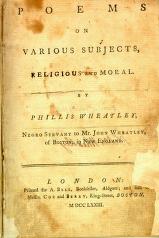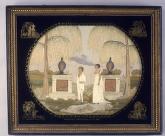|

"The New England Primer"

"Poems on Various Subjects, Religious and Moral"

Washington Memorial

Phelps mourning embroidery

Excerpts from the Diary of Ruth Pease
|
Summary and Objective
Students will understand through gravestone iconography, literature, diaries, and art that changes in memento mori symbols from Puritan mortality symbolism and its preoccupation with the tenous nature of life, to the Neo-Classical/Romantic mourning imagery suggesting resurrection and everlasting life, reflect shifts in cultural values between the mid-17th and early-19th centuries in New England.
Teaching Plan
Step 1.
Students will understand that gravestones evoke imagery by 1: Reading and discussing the opening two paragraphs of Charles Dickens" "Great Expectations". 2. Learn "memento mori" is a Latin phrase meaning "Remember you will die". It names a genre of artistic creations that vary widely from one another (gravestone carvings, poems, embroidered motifs) but share the same purpose: to remind people of their own mortality and the punishment or reward that awaits them after death. 3. Read "Common Symbols of Gravestones" from the book: "Stones and Bones of New England" by Lisa Rogak, Globe Pequot Press, Guilford, CT. 2004., Appendix A, p. 201-204 to learn the meaning of 17th to early 19th century American memento mori symbols found on gravestones.
Step 2.
Students will learn that New England Puritans: 1. derived their basic theological doctrines from John Calvin's work, "The Institutes of Christian Religion". They believed that a. the disobedience of Adam and Eve stained all mankind, leaving them corrupt, but that Jesus' sacrifice had earned God's forgiveness for a limited few-the elect b. that salvation was given only by God, and c. in predestination-God had predestined all events and had chosen all who will be saved in heaven and all who will be lost in hell. 2. The Puritans placed a great emphasis on education. They wanted a learned clergy and an educated congregation that could understand both their preachers and the Bible. 3. The written expression of religious ideas became New England's great contribution to American literature, reflected in all genres. 4. Death was an omnipresent part of life for 17th century New Englanders, striking people of all ages. Forty per cent of children in the 17th century failed to reach adulthood. Even schoolbooks repeatedly reminded children of death and God's punishment for sin. 5. The New England Primer, first published in Boston c. 1683, was the first Reading Primer designed for the American Colonies, embodying the Puritan attitude of the day. While printings of the Primer have varied over time, the standard content for beginning reading instruction has remained constant. Puritan children (and future generations of New Englanders) learned their alphabet through religious maxims depicted in woodcuts along with religious moral lessons. 6.Students will click on to view pages 11,12, and 14 from "The New England Primer". and discuss similarities in the primer's visual lesson plates and verse with memento mori symbols (hourglass, scythe, moon, etc) depicted on 17th century gravestones.
Step 3.
Students will learn that: 1. Anne Bradstreet was the first notable poet in American literature-an authentic Puritan voice. Born in 1612 England, her childhood was typical of Puritan children of that time, influenced by the forces of Calvinism. At age 16, she married Puritan Simon Bradstreet, and 2 years later, along with her husband and parents, set sail for the Massachusetts Bay Colony. Her father succeeded John Winthrop as Governor of Massachussetts, while she and her husband settled on a farm in the village of Andover, MA., where she raised 8 children. At first, she rebelled at the harsh, primitive life on the frontier of New England, but she followed her Puritan upbringing and accepted her lot as the will of God. While Anne read and wrote poetry, she knew that a Puritan community would frown upon such unseemly behavior in a woman, especially a governor's daughter! In 1650, without her knowledge, her brother-in-law, Pastor John Woodbridge, published a collection of her poems under the pseudonym "A Gentlewoman of Those Parts". This was the first published volume of poetry written by a settler in the New England colonies. 2. Students will click on the companion website to view Anne Bradstreet's memento mori poem, "In Memory of My Dear Grandchild Elizabeth Bradstreet, Who Deceased August, 1665, Being A Year and Half Old". 3. Students will read and compare stanza two, line four: "And time brings down what is strong and tall" with the New England Primer's verse, p. 14: "Time cuts down all, Both great and small". 3. Students will discuss how these verses are reflected in the gravestone motifs of the hourglass and scythe.
Step 4.
Students will learn that: 1. 18th century America was a time of change, a shift in religious, political, and cultural values. 2. This period in time is called The Age of Reason, the Neoclassic Period, or The Age of Enlightenment. 3. It was a time of new men: scientists, religious rationalists, and political philosophers, whose ideas were rooted in the classical world of Greece and Rome, the Renaissance, and the Protestant Reformation. They sought order in the natural world, in the new science. 4. The dominating idea of hell began to fade and the gentler God of natural philosophy began to replace the Puritan God of wrath. Humanism and service to man became the social ideal-theology became rational. The idea of predestination was being replaced by the belief that man is naturally good. The Puritans saw themselves as the "Chosen few" akin to Abraham in the Old Testament. People of the Age of Reason and Enlightenment saw America as the New Israel of the New Testament, the New World was idealized as a land of virtue and beauty. 5. While philosophers and writers, such as Thomas Jefferson, began to glorify a simpler, agrarian life, writers such as Ben Franklin saw it as a time of contradictions: a time of faith in both social order and a love of stability, a time of belief in man's natural rights and a devotion to revolutionary change.
Step 5.
1. Students will understand the Age of Reason, Neoclassicism, and Enlightenment are reflected in the life and writings of the first important Afro-American poet, Phillis Wheatley. Wheatley was bought on the Boston slave market in 1761 as a house servant for Susannah Wheatley. Phillis was taught to read and write by Susannah's daughter and encouraged by her owners to study astronomy, geography, and history. Wheatley also learned Latin so that she could read the works of Horace, Virgil, and Ovid, not only in English, but in their original language. 2. Students will click on Wheatley's "Poems of Various Subjects, Religious and Moral", to view p. 69-71 of her memento mori poem, "A Funeral Poem on the Death of C.E. an Infant of Twelve Months". 3. Students will discuss how a. Wheatley's poem reflects the Age of Reason-science, in lines 3-4: "Beneath him sees the universal whole, Planets on planets, run their destined round" b. they will compare the reference to sin in Bradstreet's line "By nature trees do rot when they are grown" to the gentler Enlightenment lines of Wheatley's: "Thanks be to God who snatched me to the skies, e'er vice triumphant had possessed my heart" and c. students will compare the closing lines: Bradstreet's reflecting predestination: "Is by His hand alone that guides our fate" to Wheatley's: "Prepare to join your dearest infant friend...". 4. Students will compare Wheatley's closing lines of stanza two: "exulting cherubs round clapt their glad wings" to how cherubs replaced the mortal and foreboding death's heads gravestone motifs of the Puritan era.
Step 6.
Students will understand just as the Age of Puritanism gave way to the Age of Reason and Enlightenment, so too did the harsh memento mori mortality symbols give way to Neo-Classic/Romantic memento mori mourning imagery suggesting Resurrection and everlasting life. Urns, weeping willows, winged cherubs, hands pointing heavenward, replaced the scythe, hour glass, and death's heads. America was a new nation at the close of the 18th century. George Washington was one of the first great American heroes of the Revolution to die on December 11, 1799. Students will: 1. click on Thomas Clarke's memento mori engraving "Washington Memorial" and note and discuss: a. the neo-classic dress of the mourners, hearkening back to Greco-Roman times b. the obelisk-an ancient symbol from Egyptian times representative of the sun's rays c. the hand pointing heavenward and d. the weeping willow-the most popular memento mori gravestone motif of the late 18th-early 19th centuries. 2. The students will click on Martha Phelps' memento mori embroidered artwork, "Phelps Mourning Embroidery". 3. Students will note and discuss the urn and weeping willow-two of the first memento mori mourning imageries after the Revolutionary War to replace the death's head and soul effigies. 4. Students will reference back to Lisa Rogak's Appendix A : "Common Symbols of Gravestones" and compare the memento mori symbols in these two works of art with those found in New England gravestone iconography.
Step 7.
1. Students will learn that Jonathan Edwards was an 18th century American theologian caught between two worlds: on one hand, he held to the Puritan ideas of the sinfulness of man yet on the other hand, he was a religious rationalist, a man of reason and enlightenment, who believed that man could be made good. His faith was both mystical and logical. He taught that the world was moving toward a new millennium that would begin in America. For his knowledge of the new science, for his awareness of the world ignited by Newton, Edwards has been called the first modern American. Even though he died in 1758, his works still had a powerul influence on the religious and cultural values of 19th century Americans. 2. Students will click on "Excerpts of the Diary of Ruth Pease", written in 1812, p. 1-6. 3. Students will discuss how Ruth's entry on page 1: "the number of souls on this earth ---is supposed to be 900,000,000---" reflect the age of reason-beliefs in the scientific world. 4. Students will note Ruth's entry on p. 2, "I have adopted some of Mr. Edwards resolutions". 3. Students will read and discuss Ruth's resolutions and how some, such as resolutions 1,2,4,12,14, and 15 reflect the Age of Enlightenment-a rational theology while resolutions 16, 19, 21,22, and 28 hearken back to a more Puritan attitude. 4. Students will discuss how the duality in Ruth's resolutions reflect shifts and changes in cultural values that are also reflected in the changing memento mori symbols from the mid 17th to early 19th centuries.
Step 8.
Follow-Up Activity: The students in Grade 8 at St. Mary's Elementary School in Westfield, MA, are fortunate to be within walking distance of the Old Burying Ground. This cemetery is now on the National Register of Historic Places as one of the oldest burying grounds in the United States. Burial dates from shortly after 1668 to the mid 1800's. Edward Taylor, Puritan minister in Westfield in the mid 17th century, is buried here. While many local residents regard Reverend Taylor as the first American poet, his works were not published until the 1930's. The key to gain admittance t this cemetery is available through the Westfield Athenaeum. If one does not live in this locale, a virtual tour of The Old Burying Ground may be taken by visiting the "cyndysmugmug" website. Here, one wll see the changing memento mori gravestone symbols from the mid-17th century hourglasses, death's heads and soul effigies to the winged cherubs, urns and weeping willows of the late 18th to early 19th centuries.
|




